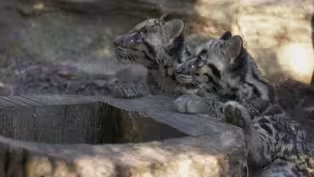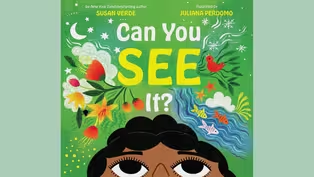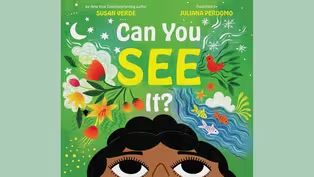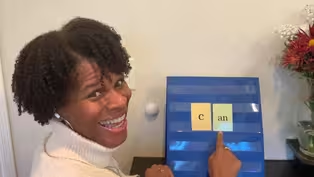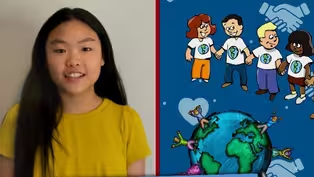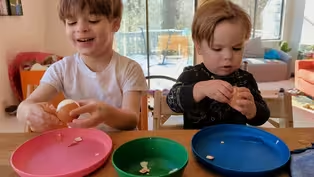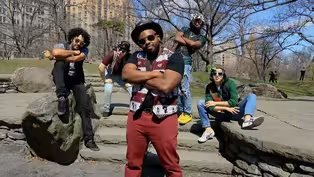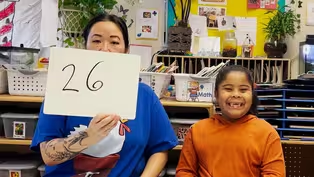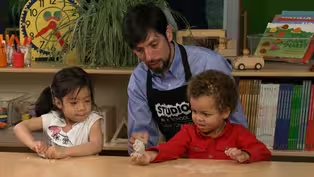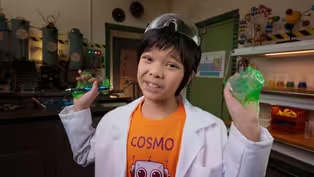
MIGHTY MORPHING MEALWORMS
Clip: 7/9/2024 | 6m 56sVideo has Audio Description, Closed Captions
MIGHTY MORPHING MEALWORMS
Learn about the four stages of a mealworm's life cycle (egg, larva, pupa, adult darkling beetle) with Krystal Balmes and Sahil from the Brooklyn Preschool of Science.
See all videos with Audio DescriptionADProblems playing video? | Closed Captioning Feedback
Problems playing video? | Closed Captioning Feedback
Let's Learn is a local public television program presented by THIRTEEN PBS

MIGHTY MORPHING MEALWORMS
Clip: 7/9/2024 | 6m 56sVideo has Audio Description, Closed Captions
Learn about the four stages of a mealworm's life cycle (egg, larva, pupa, adult darkling beetle) with Krystal Balmes and Sahil from the Brooklyn Preschool of Science.
See all videos with Audio DescriptionADProblems playing video? | Closed Captioning Feedback
How to Watch Let's Learn
Let's Learn is available to stream on pbs.org and the free PBS App, available on iPhone, Apple TV, Android TV, Android smartphones, Amazon Fire TV, Amazon Fire Tablet, Roku, Samsung Smart TV, and Vizio.
Providing Support for PBS.org
Learn Moreabout PBS online sponsorship[cheerful music] - Hello everyone.
My name is Crystal and I'm here at the Brooklyn Preschool of Science with my friend Sahil.
Sahil, can you please say hello?
- Hello.
- How are you today?
- Good.
- Awesome.
Together we are going to do a really fun hands-on science activity.
Before we start with the activity, I have a question.
What is a transformation?
Do you know what a transformation is, Sahil?
- What?
- A transformation is a complete change.
- Complete change.
- Yes.
A good example of a transformation is like how a tadpole can transform into a frog or a toad or like a caterpillar, it can transform into a butterfly.
I have something here that goes through a complete transformation.
You ready to see what it is?
- Yeah.
- Yes.
They're inside here.
- Mealworms!
- Good job!
Mealworms.
- Mealworms.
- That's right.
I'm gonna put my hand out and I'm gonna pour these mealworms on my hand, okay?
- Yeah.
- Whoa.
- Whoa.
- Look at that.
There's so many, yes?
- [Sahil] Yeah.
So many mealworms.
- [Crystal] Yes and do you know that although they are called mealworms, they're actually not worms?
- No, they're mealworms.
- Well, yeah, but you know what?
This is actually the larvae of a darkling beetle.
- Those are mealworms.
- Yeah.
Look, they're walking on the table.
So these mealworms, right now, they're not fully developed.
They're gonna go through a transformation process called metamorphosis.
Can you say that, Sahil?
Can you say metamorphosis?
- Metamorphosis.
- Good job.
Gimme five.
Awesome.
That is what their process is called.
They're gonna go through four stages in their lifecycle.
Would you like to see?
- Yep.
- Okay.
So right now, I'm just gonna put the lid on this right here.
And I'm gonna leave these two baby mealworms on the table.
Now, I would like you to look closely at what I have here.
I'm gonna show you the four stages of the darkling beetle.
Okay?
Lifecycle- - Egg!
- Good job.
Egg.
For about one to four weeks.
And then after four weeks, do you wanna see what crawls out?
- Yeah.
- Our mealworm friends.
- A mealworm.
- Yes.
You see?
And then it's like dark yellow.
It has brown stripes.
The larva is a dark yellow with brown stripes.
It has two antennas, six tiny legs, and it has a hard body called an exoskeleton.
Can you say that?
Can you say exoskeleton?
- Exoskeleton.
- Whoa.
Amazing.
Ready for the next stage of its life?
- When it comes out?
- Not just yet.
Look at that.
Can you say pupa?
- Pupa.
- Yes, pupa.
Stage three.
The pupa stage is a state of sleep that can last about two to three weeks.
And after this stage, it turns into an adult darkling beetle.
- Beetle.
- Yes.
It hatches from the pupa.
At first it's white and then it turns brown, almost black.
Look.
You see the antenna?
Six legs, a head, a thorax, and an abdomen.
This transformation process, this is called metamorphosis.
You know what we're gonna do today with our mealworms?
- Yeah.
- We are going to create a mealworm habitat.
Can you say that?
Habitat.
- Habitat.
- Do you know what a habitat is?
- Yeah.
- What's a habitat?
It's a home.
- Home.
- A habitat is a home.
We are going to provide them with shelter.
- Shelter.
- Water and food.
- Shelter, water, food.
- Yes.
Okay, so now let's look at the materials we have.
So we have our mealworms.
- Mealworms.
- We have this clear plastic container here with the lid, and the lid has some holes.
What do you think the holes are for?
So they can breathe for air.
- Breathe.
- Yeah, those are air holes.
- And mealworms drink apples from the water.
- They can drink the water from the apple.
That's right.
That's why we have apple here.
What about the oats?
What do you think they do with the oats?
- They eat.
- Yes, we have, look at that.
We're gonna provide them with some shelter, some apple so they can drink the water and some oats so that they can eat.
- Yeah.
- Now Sahil, I need your help.
I'm going to take this Dixie cup and I'm gonna fill it up with some oats all the way to the top.
Can you please carefully take those oats and pour it into the container?
Good job.
Okay, so now we have our oats in there and now can you please take one slice of the apple and put it inside the container too?
Thank you, sir.
And now we're going to take, which mealworm would you like?
Pick a mealworm.
This one here?
Okay.
So I'm gonna very carefully pick this guy up.
Whoa.
He's dancing.
- Why is he dancing?
- He's a dancer.
He's happy because he's gonna get a new home.
- A new home.
- Yes.
So we're gonna carefully take our mealworm and we're gonna place it right inside its new home.
Look at that.
Now you know what we can do?
I love this activity because we get to now take this home and we can observe and watch it go through its life cycle.
- [Sahil] Yeah.
- Yes and then when it turns into a darkling beetle, you can go to the park and set it free.
- And then what will happen?
- Maybe it will start a family.
- Family?
- Yes.
How was that activity?
- Good!
- It was good or was it great?
- Great and good.
- Oh, great and good.
Awesome.
Thank you so much for your help.
Can we say see you later to our friends?
- See you later.
- Bye-bye now.
- Bye-bye.
ANIMAL SUPERPOWERS: CLOUDED LEOPARDS
Video has Audio Description, Closed Captions
Clip: 7/9/2024 | 2m 58s | Learn about animal superpowers by watching how the clouded leopard climbs. (2m 58s)
Video has Audio Description, Closed Captions
Clip: 7/9/2024 | 7m | Isabel Simmons reads CAN YOU SEE IT? by Susan Verde. (7m)
Video has Audio Description, Closed Captions
Clip: 7/9/2024 | 7m | Isabel Simmons reads CAN YOU SEE IT? by Susan Verde. (7m)
GLUED/WELDED SOUNDS: AN AND AM
Video has Audio Description, Closed Captions
Clip: 7/9/2024 | 9m 18s | Explore glued and welded sounds "an" and "am" with Isabel Simmons. (9m 18s)
MEET THE HELPERS: THE CHANGEMAKERS
Video has Audio Description, Closed Captions
Clip: 7/9/2024 | 47s | Learn how changemakers work to make the world a better place. (47s)
Video has Audio Description, Closed Captions
Clip: 7/9/2024 | 1m 3s | Peel a hard-boiled egg with siblings Micah and Luca! (1m 3s)
Video has Audio Description, Closed Captions
Clip: 7/9/2024 | 3m 13s | Sing “Pick It Up,” a song about recycling with Fyütch. (3m 13s)
Video has Audio Description, Closed Captions
Clip: 7/9/2024 | 8m 39s | Play “Trade Up,” a two-digit place value game. (8m 39s)
Video has Audio Description, Closed Captions
Clip: 7/9/2024 | 7m 42s | Play with clay! (7m 42s)
WORDSVILLE: THE CASE WITH NO QUESTIONS
Video has Audio Description, Closed Captions
Clip: 7/9/2024 | 7m 24s | Learn the meaning of the word "inquire" in Wordsville's “The Case with No Questions.” (7m 24s)
Providing Support for PBS.org
Learn Moreabout PBS online sponsorshipSupport for PBS provided by:
Let's Learn is a local public television program presented by THIRTEEN PBS
